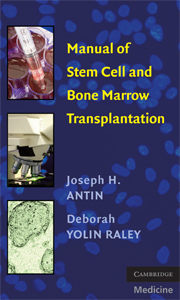Book contents
- Frontmatter
- Contents
- Acknowledgments
- Manual of Stem Cell and Bone Marrow Transplantation
- 1 Rationale for Transplantation
- 2 Types of Transplantation
- 3 HLA Matching in Allogeneic Transplantation
- 4 Stem Cell Source
- 5 Pretransplant Evaluation and Counseling of Patient and Donor
- 6 Conditioning Regimens
- 7 Stem Cell Infusion
- 8 ABO Compatibility
- 9 Engraftment
- 10 Preventative Care
- 11 Transplant-Related Complications
- 12 Graft-Versus-Host Disease – Prophylaxis and Acute
- 13 Graft-Versus-Host Disease – Chronic
- 14 Engraftment Syndrome
- 15 Infectious Disease
- 16 Graft Rejection And Failure
- 17 Gastrointestinal Complications
- 18 Pulmonary Complications
- 19 Veno-Occlusive Disease
- 20 Special Transfusion-Related Situations
- 21 Cardiovascular Complications
- 22 Neurologic Complications
- 23 Cystitis
- 24 Donor Lymphocyte Infusion
- 25 Transplantation: Regulation And Accreditation
- Appendix
- Index
8 - ABO Compatibility
Published online by Cambridge University Press: 23 November 2009
- Frontmatter
- Contents
- Acknowledgments
- Manual of Stem Cell and Bone Marrow Transplantation
- 1 Rationale for Transplantation
- 2 Types of Transplantation
- 3 HLA Matching in Allogeneic Transplantation
- 4 Stem Cell Source
- 5 Pretransplant Evaluation and Counseling of Patient and Donor
- 6 Conditioning Regimens
- 7 Stem Cell Infusion
- 8 ABO Compatibility
- 9 Engraftment
- 10 Preventative Care
- 11 Transplant-Related Complications
- 12 Graft-Versus-Host Disease – Prophylaxis and Acute
- 13 Graft-Versus-Host Disease – Chronic
- 14 Engraftment Syndrome
- 15 Infectious Disease
- 16 Graft Rejection And Failure
- 17 Gastrointestinal Complications
- 18 Pulmonary Complications
- 19 Veno-Occlusive Disease
- 20 Special Transfusion-Related Situations
- 21 Cardiovascular Complications
- 22 Neurologic Complications
- 23 Cystitis
- 24 Donor Lymphocyte Infusion
- 25 Transplantation: Regulation And Accreditation
- Appendix
- Index
Summary
Whenever possible, donors who are ABO compatible with the recipient should be selected. However, since human leukocyte antigen (HLA) and ABO types are unrelated, it is common to have HLA compatible donors who are ABO incompatible. This disparity often requires special attention. Transfusion problems may occur immediately or after a delay.
Soon after birth, antibodies form against bacterial polysaccharides that cross-react with ABO substance. Thus, type A people have anti-B antibodies without ever being exposed to type B blood. Similarly, type B people have anti-A antibodies and type O people have antibodies to both A and B, while type AB people have no antibodies. Immediate transfusion risk is due to this preformed antibody reacting with infused red blood cells (RBCs) during the stem cell product infusion. Delayed reactions reflect slow turnover of plasma cells or antibody weeks or months after the transplant, resulting in delayed erythroid recovery. When considering transfusion risks, both the red cell type and the associated antibodies must be considered. Donor recipient pairs are defined as follows:
MAJOR MISMATCH
As shown in the following table, if the recipient is type O and the donor is type A, B, or AB, there is a major ABO incompatibility. In this situation, there are preformed antibodies in the type O recipient against A and/or B substance on the donor's RBCs.
Transfusion of the unmodified stem cell product can result in an acute hemolytic transfusion reactions (AHTR).
- Type
- Chapter
- Information
- Manual of Stem Cell and Bone Marrow Transplantation , pp. 37 - 41Publisher: Cambridge University PressPrint publication year: 2009



